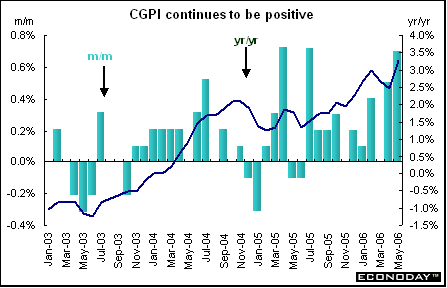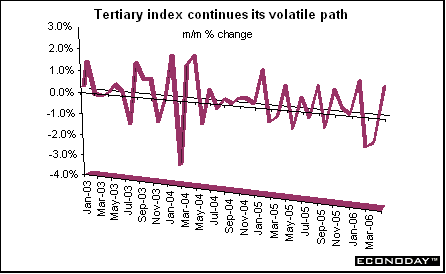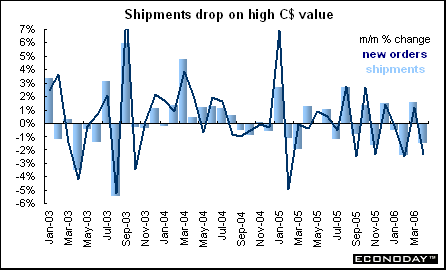There are many explanations and excuses for the erratic behavior of equities since mid-May. For example, indexes that are heavily weighted with mining companies have been particularly vulnerable to volatile commodity price fluctuations. This is especially true of the FTSE, S&P/TSX composite and the all ordinaries.
There appears to be concerted effort by central banks worldwide to curtail liquidity and sop up excess funds as inflation expectations climb. Investors are concerned that higher interest rates will slow economic growth and have a negative impact on profits. The sharp equity sell offs brought to the fore once again the U.S. dollar's role as a safe haven. Once things stabilized a bit, the dollar began to ebb downward again.
While Asian/Pacific stocks managed to recover their losses, European and British stocks did not. North American stocks were mixed. The Bolsa lost over 6 percent on Monday and Tuesday but still managed to end the week on the plus side thanks to an increase of over 6.7 percent on Thursday.
Global Stock Market Recap

Europe and the UK
It was a rough week for stocks in the UK and Europe. While the FTSE, CAC and DAX staged impressive rallies on Thursday, alas, they did not last through Friday. As a result, all three indexes were down on the week and now are below their end of 2005 levels. With investors so tremulous, it doesn't take much to get them to run for shelter. The reason for Friday's decline was an announcement by the People's Bank of China that they would require 0.5 percent more reserves to be set aside by banks beginning on July 5th in order to curb rapid credit growth and to prevent the economy from overheating. Mining stocks such as BHP Billiton were down because they rely on China for one of their main markets.

Asia/Pacific
Despite the heavy losses earlier in the week, Asian/Pacific indexes followed here were all up. However, three of the six are significantly below their end of 2005 levels. The Nikkei, Topix and Kospi are down 7.6 percent, 7 percent and 8.5 percent respectively for the year. However, investors remain very nervous about the U.S. economy. According to Morgan Stanley the current market correction is the third most severe in Asia in the past 19 years.
Japanese shares rebounded after Fed chair Ben Bernanke eased concerns about U.S. inflation Thursday. Bernanke said that higher energy prices were manageable over the long term, even though they might slow growth and boost prices in the short term. Bernanke's remarks eased concern the Fed may be forced to keep raising interest rates in the second half of the year. Exporters including Honda and Matsushita Electric benefited. The Topix and Nikkei managed to gain for the first week in six. On Friday alone, the Nikkei was up 2.8 percent while the Topix jumped by 3.3 percent.

The Bank of Japan left its monetary policy unchanged and maintained its zero interest rate policy after its two day meeting on June 14th and 15th.. At its March meeting, the monetary policy board voted to end five years of flooding the money market with excess cash and switch to a more conventional interest rate target. The bank has been trimming the balance of current accounts held at the bank to just above ¥10 trillion from ¥30 trillion to ¥35 trillion in place during the two years of quantitative credit easing. At his press conference following the meeting, Governor Toshihiko Fukui said the bank will monitor the effect of falling stock prices for any impact on the economy. The bank will get an idea of how much the dropping stock market has affected business confidence in the quarterly Tankan business confidence survey to be published on July 3rd. The Tankan is Japan's most widely watched business confidence indicator.

Currencies
After reasserting itself as a safe haven to risk aversion earlier in the week, the dollar edged lower as stock and commodity markets recovered from their sharp sell off. Some traders attributed the rally in global equity markets to Bernanke's comments on Thursday when he said that the impact of higher energy costs on other prices had been limited so far. Other traders simply thought that the selling earlier in the week had been overdone. Yet another reason for the dollar's decline was laid at the feet of the U.S. Treasury International Capital report, which showed a surprise drop in securities investment into the U.S. in April.

Reverberations were felt in the currency market from the People's Bank of China announcement on Friday morning. The commodity currencies - the Canadian and Australian dollars - dropped along with the yen. China has surpassed the U.S. and now is Japan's largest trading partner. But the yen pared some of its losses after Federal Reserve Governor Donald Kohn said that pressure on Asian currencies to appreciate would intensify.
Indicator scoreboard
EMU - May harmonized index of consumer prices was up 0.3 percent and 2.5 percent when compared to the same month last year. Excluding energy, the HICP was up 0.1 percent and 1.5 percent on the year. Food prices were up 0.5 percent and health care prices were up 0.4 percent but communications prices dropped 0.5 percent on the month.

April industrial output dropped 0.6 percent and was up 1.9 percent when compared with April of last year. One reason for the decline was fewer workdays because of Easter. All sectors were lower on the month.

Germany - June ZEW business expectations survey reading declined to 37.8 from 50 in May. ZEW blamed the expectation of higher interest rates along with market factors for the drop. The ZEW surveyed 303 German financial experts for their opinions on current economic conditions and the economic outlook for major industrial economies between May 29th and June 12th. According to ZEW president Wolfgang Franz, undesirable developments in economic policy including an anti-discrimination law, a VAT increase and higher taxes for the rich deflated expectations.

Italy - April seasonally and workday adjusted industrial production was down 1 percent and dropped 2.6 percent when compared with the same month a year ago. All sectors were down. Consumer goods output was down 1.3 percent while capital goods dropped 1.8 percent.

April world merchandise trade deficit was €1.96 billion, almost the same as the previous month and larger than a year ago. Exports were up 1.7 percent while imports were up 3.7 percent on the year. Once again imports reflect higher crude oil and national gas imports.

Britain - May producer output prices were up 0.3 percent and 3 percent when compared with last year. Core output prices which exclude food, tobacco, beverage and energy were up 0.2 percent and 2.4 percent on the year. Input prices were down 0.5 percent but were up 13.8 percent on the year. Crude oil prices were down 3.2 percent but were still up 45.6 percent on the year.

May consumer price index jumped by 0.5 percent and was up 2.2 percent when compared with last year. Upward pressures on the CPI came from gas & electric bills, goods, clothing & footware. This is above the Bank of England's inflation target of 2 percent. Core CPI which excludes food, energy, alcoholic beverages and tobacco was up 0.1 percent and 1.1 percent on the year. The retail price index excluding mortgage interest payments was up 0.7 percent and 2.9 percent on the year.

May claimant count unemployment rate remained at 3 percent for the third month and despite an increase of 5,800 unemployed. The International Labour Organisation unemployment rate for the three months ending in April was 5.3 percent, the highest rate since 2002. The number of unemployed increased by 77,000 to 28.94 million and the highest since records began in 1971. Despite the increase in unemployed, employment was up 130,000 and bringing the participation rate to 74.7 percent.

Average earnings for the three months ending in May were up 4.4 percent when compared with the same three months a year earlier. Excluding bonuses, earnings were up 3.8 percent. Average earnings were up 5.3 percent for the manufacturing sector while private sector earnings were up 3.8 percent. The Bank of England's target for earnings growth is 4.5 percent.

May retail sales were up 0.5 percent and 4 percent when compared with the same month a year ago. Retail sales account for about 33 percent of total household spending and will be a positive contribution to second quarter GDP growth. Non-food sales were up 0.9 percent while food sales were unchanged. Clothing and footwear sales were up 1.5 percent and department store sales were up 0.7 percent.

Asia
Japan - First quarter revised gross domestic product was up 0.8 percent and 3.8 percent when compared with the same quarter a year ago. On an annualized basis, GDP was up 3.1 percent. Capital expenditures were revised upward to an increase of 3.1 percent from the preliminary reading of 1.4 percent. The GDP deflator declined 1.2 percent on the year.

May corporate goods price index was up 0.7 percent and 3.3 percent when compared with May of last year. Prices for non-ferrous metals and petroleum and coal products were up while prices for electrical machinery and equipment were down.

April tertiary sector index was up 1.3 percent and 1.5 percent when compared with the same month a year ago. The tertiary index reflects activity in 11 service industries, among which are utilities, transport, telecommunications, wholesale and retail, finance and insurance, real estate, restaurants and health care.

Americas
Canada - April factory shipments declined 1.5 percent and were down 0.1 percent when compared with last year. Most of the loss stemmed from a substantial drop in aerospace products and parts which plummeted 37.8 percent after soaring 38.2 percent in March. Excluding this industry, shipments were down 0.4 percent. Fourteen of 21 manufacturing industries accounting for 66 percent of total shipments were down in April. Durables were down 1.8 percent while nondurables were down 1.1 percent. New orders declined 2.3 percent and 1.1 percent on the year. Excluding aerospace, new orders were down 1 percent. The backlog of unfilled orders were down 0.9 percent but were still up 8.3 percent on the year.

Bottom line
With all eyes on the World Cup abroad it is probably a good thing that only few new pieces of economic information will be available this week. And there are no major central bank meetings either. But market players being market players will undoubtedly begin their FOMC vigil in anticipation of the Fed meeting on Thursday, June 29th.

